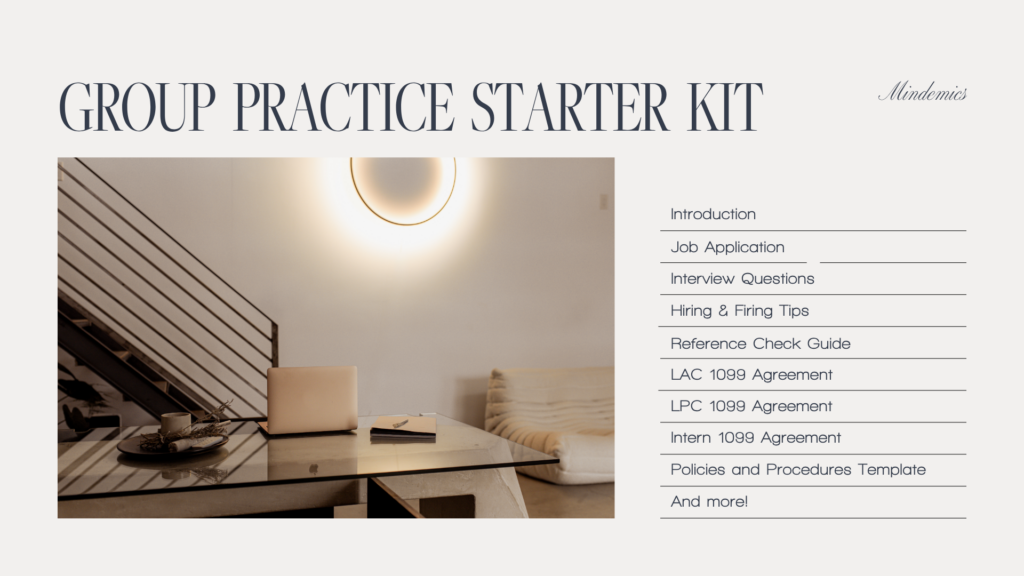
Starting a private practice is one of those things that sounds simultaneously thrilling and terrifying. If you’re anything like I was when I first took the leap then you’re probably juggling excitement with a healthy dose of imposter syndrome. Grad school provided the tools for the clinical side, but the business side? I don’t know about you but that can feel like a different world! If you’ve been wondering how to start a private practice and actually make it sustainable, I want to share some of what I’ve learned along the way.
I’ve walked the road from solo clinician to group practice owner and while it wasn’t always smooth, it was absolutely worth it. Let’s talk about what a strong private practice setup can look like (especially if you’re building something that might grow into a group practice down the line!).
Step 1: Know Your Why
Those who know me know I’m a “why” girl. I’ve found it so helpful to know your purpose before you begin. Private practice is more than a career move, it’s really a values-driven decision. Whether you’re after more autonomy, a better work-life balance, or the freedom to work with your ideal clients…your motivation matters. Getting clear on your “why” gives direction to your therapy business plan and helps you make aligned choices especially as you grow. Write down your reasons. Refer back to them when things feel overwhelming.
Your “why” can help you gain clarity when faced with tough decisions like setting limits, enforcing policies, or letting go of misaligned opportunities.
Step 2: Build a Foundation
There’s a few business logistics to keep in mind that you might not have considered yet…
- Forming your business (creating an LLC or PLLC)
- Securing an EIN
- Setting up professional liability insurance
- Understanding board rules and ethical guidelines
- Choosing whether to operate as a sole proprietor or bring on contractors
Listen, I know that as therapists we don’t always share a love of the “paperwork” side BUT these are important steps that help you build the foundation of a private practice.
Step 3: Map Out a Mental Health Business Plan
Having a general sense of direction helps create the map for what comes next. Some of the factors I considered early on included…
- Defining my niche
- Setting fee structures and goals
- Understanding my client base
- Planning for private practice growth
Your business plan can feel a little like a vision board and I know for me it has been so empowering to see the vision come to life! Especially in the world of private practice you want to ask yourself what kind of clientele you are seeking to support so that you know the best paths for marketing, referral networks, and staffing.
Step 4: Prep to Hire
Think about your practice culture. What kind of environment are you creating? What kind of people will thrive there? Define your non-negotiables and your “nice to haves.” Building a cohesive team has so many benefits in our work. When it comes to hiring, consider the importance of…
- A clear job description
- Application forms/questionnaires
- An internal checklist for reviewing applicants
You can also prepare in advance your interview questions and identify what more of what you’ll be looking for. Personally I find that sharing your practice vision with applicants can help create more clarity surrounding what you are looking for as a practice owner.
Once you’re ready to hire, having a process you can put in motion helps make things a bit more seamless. Here’s my advice:
- Screen applicants with an application or questionnaire
- Conduct interviews that assess alignment (not just experience)
- Ask clinical and cultural fit questions
- Reference check with clarity and structure
This doesn’t have to be a huge operation. But the more prepared you are, the more confident you’ll feel. Hiring shouldn’t feel like a gamble. It should feel like an informed decision. I remember the first time I had to turn someone down. Obviously not super fun feelings, but because I had a clear vision, it gave me the confidence to move forward without regret.
Make your hiring process human! Communicate timelines clearly. Respond even when the answer is no. Respectful communication sets the tone for your practice’s reputation in the professional community.
Step 5: Onboarding
Onboarding in private practice should (in my opinion) be much more than a welcome email. Especially if you are hiring therapists as interns or early in their career there are so many opportunities within onboarding to create more confidence for your clinicians. Make sure your onboarding includes:
- A welcome packet or handbook
- Training on EHR, documentation, and admin tools
- Expectations for communication, billing, and case consults
Onboarding creates an opportunity to show that you value not just your clients, but your clinicians too! New hires shouldn’t feel like they’re jumping into a moving train with no support. Ease them in thoughtfully, and (trust me!) they’ll be more engaged long-term. Regular check-ins especially during the first few months can help identify questions or concerns before they become problems.
Step 6: Prepare Your Contracts
I know, more paperwork! No matter the clinical setting, you want your employees to have a clear understanding of…
- Role expectations
- Payment terms
- Termination clauses
- Non-disclosure and HIPAA responsibilities
Having distinct contracts for interns, associates, and independently licensed therapists protects you from the legal side which, hopefully won’t be needed, but it’s better to be prepared.
You’ll also want to define things like expectations around continuing education or whether marketing is a shared responsibility. A good contract helps prevent resentment and confusion later on!
Step 7: Define Your Role
Running a team can feel like a lot of pressure sometimes especially when you’re the one “in charge”. I have found so much success with my team through being clear about the vision, communicating effectively, and providing lots of support. Build a feedback culture. Ask your team what’s working and what’s not. Schedule regular 1:1s. Provide supervision that’s actually supportive and not just a checkbox!
Being a great leader isn’t about being perfect. It’s about being consistent, accessible, and growth-minded. You’re setting the tone. The clearer you are about your expectations and values, the more easily your team can align with them. Create pathways for growth within your practice…whether that’s clinical training, mentorship roles, or future leadership opportunities. People stay where they feel seen and invested in!
When it comes to you, my encouragement would be to make time for rest, protect your boundaries with admin time, rely on others (we can’t be good at ALL of it!), and create space for you to disconnect when needed.
Step 8: Track Your Progress
One of the coolest parts of seeing growth happen over time is in the numbers. Knowing where you started and getting to see how far you’ve come is progress that can look/feel different than progress with a client! I know for myself and now for my team there is a confidence that builds when you see measurable growth too.
Start by tracking:
- Monthly income and expenses
- Average revenue per clinician
- Retention rate and average number of sessions per client
- Cancellation/no-show rates
Private practice growth isn’t always linear! Sometimes it’s more profitable to pause and solidify systems than to onboard another clinician. That’s the beauty of private practice…you get to make decisions that align with your values!
Step 9: Build a Support Network
The move to private practice (and especially to group ownership) can feel lonely at times. You’re navigating new challenges and often…you’re doing it solo. Finding a consultant who specializes in your niche or joining a local networking circle are ways to start building a support system.
These connections provide insight, encouragement, and allows you to feel well-resourced when it comes to serving your clientele. Even as a leader you need space to ask hard questions and process uncertainty. You don’t have to do it all alone!
Step 10: Let Your Practice Align to Your Values
From the language on your website to the way you structure your contracts, every detail can communicate something about the culture you want to create and the clientele you’re seeking to support.
For me, it was helpful to float back to my earlier experiences as a therapist and see what I wish had looked different and how I wanted to support those that would come after me! Grad school only prepares you in so many ways. Group practice marketing is a big part of owning a private practice and when you know the direction of your business it can help give you clarity when it comes to the marketing side.
Getting Started
Learning how to start a private practice is about more than checking off boxes. It’s about building something aligned, sustainable, and uniquely yours. From day one through private practice growth, the systems you set up now will shape your path ahead.If you’re looking for practical tools that save you time, protect your practice legally, and guide you through hiring with confidence then check out our Group Practice Starter Pack*. Curated by a therapist, for therapists. Every resource inside is something I wish I had when I was building my own therapy business!

